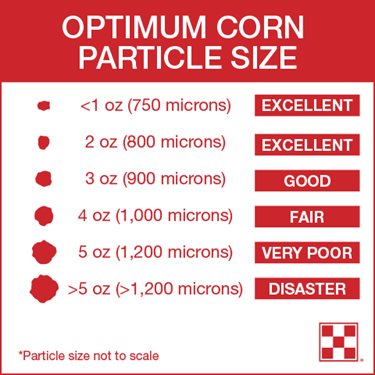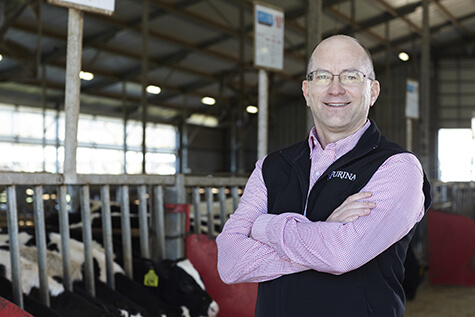
Stretch Ground Corn Supply Farther
Cow : Management
What if you could stretch your corn supply farther just by re-evaluating how it is incorporated in your dairy cow ration? What if it also helped improve milk production?
It’s not too good to be true. Evaluating how you use feed ingredients, like ground corn, in your dairy cow ration can help you improve your income over feed cost and enhance profitability.
Think about this way – a sugar cube takes longer to dissolve in your coffee cup compared to granular sugar. That’s because granular sugar has more exposed surface area compared to a sugar cube and, therefore, dissolves quicker.
A cow’s rumen works in a similar manner. Rumen bacteria can digest finer corn particles more quickly than cracked or whole corn. Ground corn’s smaller particle size can help improve feed efficiency when feeding dairy cows.
Research has shown that there’s up to a 5.9-pound dairy milk production advantage in feeding finely ground corn over cracked corn.1Evaluate particle size
When evaluating corn particle size, shoot for an average particle size of 750 to 850 microns or less. While lab testing is the most accurate method, microns can be estimated on-farm using a hand-crank flour sifter.
Weigh out 10 ounces of ground corn and sift the sample until all particles and fines that can get through the screen have done so. Weigh out the remaining particles on the screen.
Compare the weight of the remaining material on the screen with the following recommendations:
Adjust your grinding process as needed based on results.
Whether you’re purchasing ground corn from a mill or grinding it on-farm, make sure the particle size is ideal for your cows to digest and put the energy towards milk production.
Learn more about how Purina partners with farmers across the country to do what’s best for their herds.
1 Plascencia, A. et al, 2009. Influence of Cracked, Coarse Ground or Fine Ground Corn on Digestion, Dry Matter Intake and Milk Yield in Holstein Cows, Journal of Applied Animal Research, 35:2, 149-154.
It’s not too good to be true. Evaluating how you use feed ingredients, like ground corn, in your dairy cow ration can help you improve your income over feed cost and enhance profitability.
Cracked or ground corn?
Your cows’ ability to digest corn often comes down to particle size.Think about this way – a sugar cube takes longer to dissolve in your coffee cup compared to granular sugar. That’s because granular sugar has more exposed surface area compared to a sugar cube and, therefore, dissolves quicker.
A cow’s rumen works in a similar manner. Rumen bacteria can digest finer corn particles more quickly than cracked or whole corn. Ground corn’s smaller particle size can help improve feed efficiency when feeding dairy cows.
Research has shown that there’s up to a 5.9-pound dairy milk production advantage in feeding finely ground corn over cracked corn.1
Evaluate particle size
When evaluating corn particle size, shoot for an average particle size of 750 to 850 microns or less. While lab testing is the most accurate method, microns can be estimated on-farm using a hand-crank flour sifter.Weigh out 10 ounces of ground corn and sift the sample until all particles and fines that can get through the screen have done so. Weigh out the remaining particles on the screen.
Compare the weight of the remaining material on the screen with the following recommendations:
- < 1 ounce (750 microns) = Excellent
- 2 ounces (800 microns) = Excellent
- 3 ounces (900 microns) = Good
- 4 ounces (1,000 microns) = Fair
- 5 ounces (1,200 microns) = Very poor
- >5 ounces (>1,200 microns) = Disaster
Adjust your grinding process as needed based on results.
Whether you’re purchasing ground corn from a mill or grinding it on-farm, make sure the particle size is ideal for your cows to digest and put the energy towards milk production.
Learn more about how Purina partners with farmers across the country to do what’s best for their herds.
1 Plascencia, A. et al, 2009. Influence of Cracked, Coarse Ground or Fine Ground Corn on Digestion, Dry Matter Intake and Milk Yield in Holstein Cows, Journal of Applied Animal Research, 35:2, 149-154.



